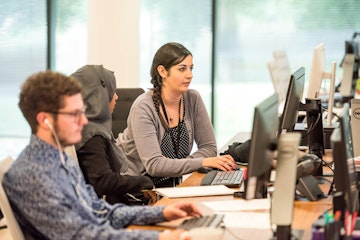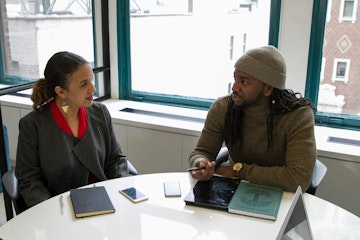Founder Spotlight
Founder Spotlight: Scott Jones, Eleven Fifty

![]()
Written By Liz Eggleston

![]()
Written By Liz Eggleston
Course Report strives to create the most trust-worthy content about coding bootcamps. Read more about Course Report’s Editorial Policy and How We Make Money.
Course Report strives to create the most trust-worthy content about coding bootcamps. Read more about Course Report’s Editorial Policy and How We Make Money.

Eleven Fifty is a unique accelerated learning environment where students learn in prolific entrepreneur Scott Jones's Indianapolis, Indiana home (of MTV Cribs fame) and are rubbing elbows with techie Scott himself, who has started a dozen+ companies, raised over $250 million in capital, and is responsible for voicemail, as we know it today. We catch up with Scott and co-founder Matt McIntyre to chat about the inspiration for Eleven Fifty, what makes their courses unique, and their APPrenticeship program!
Tell us about your background and how it led you to start Eleven Fifty.
Well, my career in tech all started with voicemail; after Indiana University, I was a research scientist at MIT’s Artificial Intelligence Lab for a couple of years then started a company across the street from the Lab with a Harvard buddy that soon became the world’s most successful voicemail company, with over 2.5 billion subscribers globally, running circles around the biggest company in the world at the time, AT&T. We sold the company for $842 million.
Thinking I would try out retirement at age 30, I promptly learned how to fly planes, jets and helicopters. Not wearing “retirement” too well though, I vowed to “never do that again,” and I subsequently started a Midwest venture capital firm called Gazelle TechVentures and a startup company called Escient which grew fast by acquiring about a dozen hand-picked niche technology companies and distilling it all down into 5 operating companies, one of which you might have heard of: Gracenote, which was backed by Sequoia, and which still powers iTunes music discovery and other music services, delivering over half a billion lookups daily. We sold that company a few years back for $260 million.
I also started PrecisePath Robotics which has recently been acquired by MTD, a company that makes lawn equipment for Sears, Lowe’s, and others.
My latest venture has been ChaCha, which caused me to realize that there’s a real dearth of programming talent at the right level to crank out high quality apps with excellence and with speed. It’s a problem on the coasts and it’s a problem here in the Midwest.
It occurred to me that perhaps I could get something going right here in the Midwest that attracted smart individuals who wanted to become even more talented mobile or web developers. While many schools talk about being hands-on, we take it to a new level with our immersive courses that involve students cranking out code nearly from the moment they start until they leave 7 long days later. For example, students crank out their own “billion dollar apps” that closely mimic Snapshot, Tender, and Evernote. We call them ElevenChat, ElevenDates, and ElevenNote. Students upload their polished apps into the store and they learn Testflight too so all their friends can use their apps. It’s a great resume builder and confidence booster, not to mention cementing the critical skills to be a successful app developer. I don’t know any other course that gets students up the learning curve as fast. Our methodology is unique and special. We’ve had students from other training programs try ours thinking that it won’t be much different, but they are blown away by their fast progress using our unique methodology.
In your past experience have you been involved heavily in the technical side of your businesses?
Scott: Yes, in the voicemail days, I built the voicemail system- I did all the C coding in those early days, including hacking the UNIX kernel for custom-built hardware, similar to what Google did a decade later.
Then, as I moved into venture capital and startups, my focus became less coding and more business. I’ve raised over $250 million for my businesses and started over a dozen companies, in addition to serving as a director or advisor to dozens of startup boards and a few public company boards.
When did you start The Eleven Fifty courses?
Scott: We just started in the summer of 2014. We’ve already had a couple of awesome 7-day Swift/iOS immersive courses and those students are raving about their experiences.
And that first session was in iOS?
Scott: It was in iOS, yes. It was our soft launch, and we had insiders taking the class…it was great. Three of my sons, ages 18, 20, and 22) who are now at Indiana University taking Computer Science, took the Swift/iOS class with their friends and they all loved it. Then, we opened up the course publicly to companies that sent their employees and to students who wanted to greatly improve their skills and prospects.
What did you learn from the first cohort? What have you changed or iterated on after finishing the first cohort?
Scott: Our instructor, Terrence Kunstek, tuned up fast to provide a hands-on methodology where all students wrote their code individually but in unison, with nobody left behind. It’s a very powerful methodology. There is no book. Students end up becoming extremely collaborative with each other. In the course, there’s a lot of focus on real world experience from our veteran instructors. We talk about real world problems that arise, whether it be memory management or security, or simply getting your app approved quickly in the store; those sorts of things. There are the other dimensions that are the real world; our courses are pragmatic, they are not just academic.
How many people were in the first class?
Scott: We had 9 in the first class and a dozen in the second class.
Is that the cohort size you want going forward?
Scott: We’re shooting for 15 in each class. We can accommodate between 12 and 20. The room we usually do this in is called the Digital Palace; it’s the number one residential home theater in the world, ranked by MTV Cribs and other organizations. It’s a really cool environment, and, incidentally, it’s underground so there are few distractions – mobile phone voice calls and texting don’t work well there…. but our apps work just fine!
Tell us about the APPrenticeship program and what makes it different?
In our APPrenticeship program that we’ve created, students can take our courses and then immediately start working on real projects for which we pay them apprentice wages while they continue to learn by “swimming in the deep end.” Students are working on real world projects under our roof as we subcontract building apps for other companies. As soon as apprentices are ready, we encourage them to “leave the nest” and “fly” with their significant new skills.
It’s a really interesting equation because we can immediately take students from the classroom to writing code that’s going to be live on the app store and used by real people. We think that combination is pretty spectacular
Matt: I think the biggest difference as Scott said earlier is the academic side of bootcamps vs. the real world side of it – we focus on the real world aspects from the very beginning. You’re not sitting in front of a textbook and turning pages. Your hands and mind are in the code every day. And then you move on to publishing real world apps with the potential of being hired in an apprenticeship program and then moving to continue to build real world apps.
Scott: One of the complaints we had heard about other bootcamps was that students would go to bootcamps yet they weren’t getting hired because companies were saying “You just don’t have enough real world experience yet.” Even in the 12-week courses, do students really have what they need? We offer the APPrenticeship program where they can work for a few weeks or even a year and have these “training wheels on” with the help of an ever-present mentor. There’s a 6:1 ratio; 6 apprentices to one mentor.
Interestingly, since we’ve announced the APPrenticeship, we’ve had a flood of interest from people and companies who want us to develop their apps.
The classes are held in your home. What was the decision behind that and are you happy having people learning in the space?
Scott: I love it because I’m a lifelong learner. You asked earlier if I was more involved in the technical or business side. Well, I’ve been out of the technical side long enough. I work with engineers all the time, but I haven’t actually written lines of code for a decade, maybe two. So I’m taking these classes myself, and I’m starting to code again. I love that I can roll out of bed and go downstairs to Eleven Fifty Hall, and be taking classes that bring me up the learning curve fast.
Immersion is the way I’ve always learned anyway, and the fact that I can have an immersive course happening in my home downstairs, practically every day… I love it.
You started with mobile and iOS. Do you expect somebody to take multiple courses?
Scott: I would expect that people will have such a good experience that they will take multiple courses. We’re already getting people interested in signing up for the full stack of training. Some of those who took our first course have already signed up for the advanced immersion course on iOS8.
We offer an a la carte menu. Students can piece together these 7-day immersives and come out, over a period of 12 weeks or 6 months, with a really nice full-stack education.
Matt: The other side of that too is our apprentices will have the opportunity to take those classes. So an apprentice that comes in just for the iOS course will certainly be offered the chance to take the additional stack.
How experienced should an applicant be in order to apply for a workshop?
Scott: I don’t think we want to start with a complete newbie who has never written a line of HTML code or anything. I think we want somebody preferably that has some object-oriented background. The ideal student may or may not have a comp sci degree, but they’ve got some coding experience.
I like to say that, instead of taking people from 0 to 60 in a week, we’re taking them from 20 to 120, over two immersive course that are taken a few weeks apart.
While the immersives do require “some” programming experience, we’ve decided to offer a “drink from the firehose” introduction to programming and computer science that will take just one weekend. This would allow most people who have no programming background to still benefit from our immersive courses on app and web development.
How did you develop the curriculum for each of these courses? How are you structuring those 7 days?
Scott: Apple did us a favor by putting quite a bit of material about Swift on their developer site so we’ve borrowed some of that to guide us.
Our decision to get students building at least three “billion dollar apps” in a frenetic week really guides the curriculum, and it exposes students to everything about Swift and iOS. Terrence, our instructor, is very good at conveying essentials to students in a way that they “get it”, and he’s also good at building an exciting curriculum. Basically, he built this curriculum for the Swift IOS framework class in 6 weeks. We’re also using a similar format for all the other courses like Android, Java/Spring/MVC, Ruby/Rails, and Python/Django/microframeworks.
All the courses fit together. If you take the Swift iOS course and then follow it with Java/Spring then you’re really learning full stack: the front-end and the back-end.
Is Terrence the instructor for all of those courses listed on the website?
Scott: No, Terrence is the lead instructor for the group, which is expanding rapidly. Terrence’s specialty is iOS. He knows back-end and Android but those are not what he would consider his forte so we’ve brought on very experienced instructors/mentors to handle the other areas.
Is there a structured curriculum as part of the APPrenticeship or is it just learning on the job?
Scott: It’s all about learning on the job, i.e. “learn by doing” with the help of an experienced mentor, and with the ability for them to sit in on additional courses. Incidentally, we don’t just do the 7-day classes, we do 2-day weekend immersives. They can be fitting those in along the way to get one heck of an education. I wish this was around during my college years!
Is that free for them or will they pay for those as well?
Scott: Apprentices get a special discount. In some cases, we can provide full scholarships, when it makes sense.
What does Eleven Fifty mean?
Scott: Part of me wants to just leave it out there as a mystery; if you take the class, you will know what it means when you walk in the door.
Since the classes aren’t long-term immersive classes, who do you see as your students? Career changers? People who want to upskill for their current jobs?
Scott: We think that there are two primary audiences for these courses. The one group comprises those who are already developers--maybe they are Web developers at Exact Target here in Indianapolis or Angie’s List, but they’re interested in building apps. By upgrading their skills, they know that they can go from industry average salary of $60-65K and jump up to the $80-85K level if they’re also proficient mobile app developers in addition to being just web developers.
Then the other group comprises students who have either just graduated from college and not landed the position they really want or it’s the entrepreneur that really wants to hone his or her skills or at least understand how apps are built.
We find that it’s about 50-50. That was the case in the first and second classes we offered.
Did you notice that people were mostly from Indianapolis in the last cohort?
Matt: In the first classes, we had a few from Chicago too, but we foresee this special immersive, hands-on, highly-productive equation having a lot of drawing power from the coasts, and even beyond US borders.
Are there plans to expand outside of Indianapolis? What’s on the horizon?
Scott: We want to get it right with this one but there’s definitely an intention to be on the coasts. We’ve even kicked around the idea of opening a branch in Hawaii.
Where in Hawaii?
Scott: Probably Maui. It’s early in the thought process but wouldn’t it be cool to do an immersive out there?
Do you want to add anything about Eleven Fifty?
Matt: The biggest message we’re trying to get across is this is less academic or “by the book.” This is “get your hands dirty” from day one. This is 9 a.m. to 9 p.m. for seven days straight.
Want to learn more about Eleven Fifty? Check out their School Page on Course Report or their website here!

Liz Eggleston, CEO and Editor of Course Report
Liz Eggleston is co-founder of Course Report, the most complete resource for students choosing a coding bootcamp. Liz has dedicated her career to empowering passionate career changers to break into tech, providing valuable insights and guidance in the rapidly evolving field of tech education. At Course Report, Liz has built a trusted platform that helps thousands of students navigate the complex landscape of coding bootcamps.










Sign up for our newsletter and receive our free guide to paying for a bootcamp.
Just tell us who you are and what you’re searching for, we’ll handle the rest.
Match Me